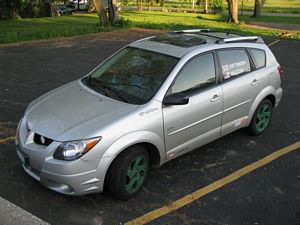|
By accessing/using The Crittenden Automotive Library/CarsAndRacingStuff.com, you signify your agreement with the Terms of Use on our Legal Information page. Our Privacy Policy is also available there. |

The American Road: Road Worthy
|
|---|
|
|
 "The American Road" is a series of articles for British readers about what it's like to be an American driver.
"The American Road" is a series of articles for British readers about what it's like to be an American driver.
Opinions expressed by Bill Crittenden are not official policies or positions of The Crittenden Automotive Library. You can read more about the Library's goals, mission, policies, and operations on the About Us page.
|
The American Road: Road Worthy
Bill Crittenden
DriveWrite
May 8, 2014
I’d like to tell you the tale of my car. It’s a 2003 Pontiac Vibe, which is basically a Toyota Corolla Matrix wagon with Pontiac body panels and Pontiac orange interior gauges.
After owning the car for a few years, my family fell on hard times. We, unfortunately, desperately needed our car to get me to work yet didn’t have the money to keep it up as we should have.
A tire went flat. The spare went on, and it says to use it a maximum of 50 miles. Round trip to and from work is 45 miles, and I did that for a few weeks before getting a replacement tire. Then another tire went…and another…and another. Over the course of two years, I kept just one step ahead of having two tires flat on my car at the same time, putting several THOUSAND miles on that sturdy little donut spare that after spending time on all four corners of my car at one point or another still sits in my trunk, like a good soldier ready to be called on again despite already having served above and beyond the call of duty. Someday, when I don’t have to drive the Vibe every day and have a bigger place, that tire will be on display in my office.
It wasn’t just the tire, either. I lost a worn brake pad by having it slip out of the caliper. After plowing my way out of the snow bank I tossed the car into to avoid a crash, I finished the drive to work and home again grinding directly on the calliper. I bought a set of cheap pads when I got home and stuck one in there to keep the calliper from grinding on the rotor, and replaced the driver’s side pads. I was running on a spare tire and one front brake for the rest of the winter.
After our family situation improved I finally fixed these little issues, only to be hit with another set of problems. A frozen latch sent my hood into my windshield at 55 mph on a subzero day, and since then I’ve got a cracked windscreen to match the cracked exhaust I received driving through a cold flooded roadway. The latch cost $120 but instead I picked up a $10 set of racing-style hood pins to secure it back down.
So, you may be wondering, how in the HELL did my car pass inspections?
The simple answer is: It didn’t. There are none. No MOT, no emissions test since I live in a rural county. Nothing. What passes for “inspections” are simple. Can you drive past a cop without getting pulled over for something glaringly obvious? So far, my little car has passed that test every time.
I’ve seen people with crash damage use flashlights duct-taped into the hole where the headlight was. Retail stores sell translucent red cellophane tape to cover over broken tail light lenses.
Most of our accessories at the parts store say, “for off road use only” because they’re not DOT legal, but since nobody ever actually inspects the vehicles, they’re bought and installed by the thousands. My car’s auxiliary lights are among those, but then I don’t use them except in extremely bad weather when no one’s around.
The harshest sanction we can ever receive due to a poorly maintained vehicle is a possible court judgment against us for being responsible for an accident. But with millions of people on the edge of financial crisis (I had to dig through the change cup for quarters to get enough gas to get home on a few occasions) and still desperately needing those cars for their jobs, as well as the plain ol’ “it won’t happen to me” attitude and quite a few ‘shadetree hacks’ who haven’t seen a torque wrench in their lives, roadworthy in America really comes down to four basic things: will your car 1.) physically move down the road with 2.) license plate visible, 3.) headlights, turn signals, and all brake lights working, and 4.) do so at a volume lower than a Boeing 747 at takeoff?
Can your car do all that? Congratulations, your car is ready for the American highway!

















 "The American Road" is a series of articles for British readers about what it's like to be an American driver.
"The American Road" is a series of articles for British readers about what it's like to be an American driver.

